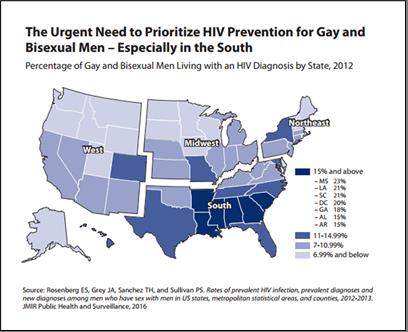New analyses offer clearer picture of where to target HIV prevention and care efforts to reach gay and bisexual men at greatest need
Emory University researchers, in collaboration with the Centers for Disease Control and Prevention (CDC), released a new report this week presenting new estimates of the MSM population size and the estimated rate of HIV among MSM in the United States at the state, city, and county levels. The new estimates provide important information that health departments can use - along with standard surveillance data and local knowledge of community needs and resources - to identify and support HIV prevention and care for MSM communities that are most affected. According to the report released in the Journal of Medical Internet Research, HIV prevalence among MSM in the United States was 15 percent in 2012, but rates varied dramatically by geographical areas - of the 25 metropolitan statistical areas with the highest levels of MSM living with an HIV diagnosis, 21 were located in southern states. These articles were released in conjunction with a commentary by CDC scientists that explains the importance of population denominators for the calculation of disease rates for MSM populations and a second commentary by Dr. Ron Valdiserri, from the Bloomberg School of Public Health, Johns Hopkins University, which highlights the urgent need to reduce HIV disparities among MSM in the United States.
estimates provide important information that health departments can use - along with standard surveillance data and local knowledge of community needs and resources - to identify and support HIV prevention and care for MSM communities that are most affected. According to the report released in the Journal of Medical Internet Research, HIV prevalence among MSM in the United States was 15 percent in 2012, but rates varied dramatically by geographical areas - of the 25 metropolitan statistical areas with the highest levels of MSM living with an HIV diagnosis, 21 were located in southern states. These articles were released in conjunction with a commentary by CDC scientists that explains the importance of population denominators for the calculation of disease rates for MSM populations and a second commentary by Dr. Ron Valdiserri, from the Bloomberg School of Public Health, Johns Hopkins University, which highlights the urgent need to reduce HIV disparities among MSM in the United States.
Because these analyses look at MSM population size and HIV rates at more granular levels of geography, they provide an additional tool for regional and local public health action and further evidence for the need to prioritize HIV prevention efforts for MSM and particularly for MSM living in the South. The southern United States continues to experience the greatest numbers of HIV infections, illness, and deaths of any U.S. region, and many of its citizens lack access to quality HIV prevention and care.
How CDC is Working to Expand and Strengthen Prevention Efforts
In recent years, CDC has expanded and strengthened its support for HIV prevention in the South and has realigned prevention resources to more accurately reflect the current epidemiology of HIV infections. Between 2010 and 2015, CDC increased its total funding to southern health departments and community-based organizations by 22 percent, from $165 million to $201 million. While the challenges to effective HIV prevention in the South remain significant, they are surmountable with the HIV prevention tools we have available today. CDC’s updated issue brief HIV in the Southern United States presents the status of HIV in the South, the unique factors driving HIV in this area, and how CDC is responding to strengthen HIV prevention efforts in the region.
In a new blog posted to AIDS.gov, Dr. Eugene McCray, Director of the Division of HIV/AIDS Prevention at CDC emphasizes how Emory University’s results can be used by states to better focus HIV prevention for MSM and the importance of using proven HIV prevention tools in the most optimal ways to address the dramatic disparities in HIV rates seen among MSM in the U.S., particularly in the South. Making HIV prevention work for all MSM, no matter where they live, is among CDC’s top priorities. But it will take action from everyone – including federal agencies, states, cities, and local communities, to ensure that the most effective prevention strategies are reaching MSM communities that are most in need.

